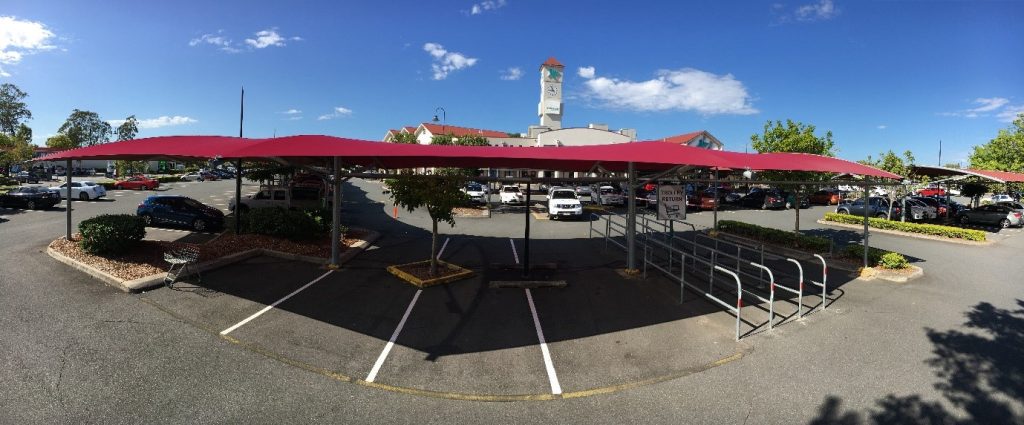YOU ARE HERE:

Innovations in Car Park Shade Technology: Paving the Way for a Smarter and Sustainable Future
Jamie Howard In Commercial Shade Structures, Car Park Shade Structure
In the scorching heat of the summer sun or amidst the unpredictable weather conditions, finding a shaded spot for your car becomes a coveted luxury. This is where commercial car park shade structures step in, providing a haven for vehicles and offering a range of benefits. Let us explore the intricacies of commercial shade structures for parking lots, exploring what they are, the advantages they bring, the types of fabric used, and the essence of parking shade.
What is a Shade Structure?
A shade structure, in the context of commercial car parks, is a carefully designed and engineered construction that provides shelter and protection for vehicles from the harsh elements of weather, particularly sunlight and rainfall. These structures are not just functional but also add an aesthetic appeal to the parking space, creating a more inviting environment.
The primary purpose of a shade structure is to mitigate the impact of weather conditions on vehicles, ensuring they are shielded from the damaging effects of prolonged exposure to sunlight, rain, and hail. These structures come in various forms, ranging from simple fabric canopies to more intricate designs that blend seamlessly with the architecture of the surrounding area.
Paving the way for a smarter and sustainable future
As the world grapples with environmental challenges and the need for resource-efficient solutions, commercial shade structures contribute significantly to creating a more sustainable urban landscape and play a pivotal role in paving the way for a smarter and sustainable future. Here’s how:
- Energy Efficiency and Climate Control: By reducing direct exposure to sunlight, shade structures help mitigate the urban heat island effect. This, in turn, lowers the ambient temperature in parking areas and adjacent spaces, reducing the overall energy consumption for air conditioning.
- Rainwater Harvesting and Management: Commercial car park shade structures often use water-resistant fabrics, which not only shield vehicles from rain but also facilitate rainwater harvesting. Collected rainwater can be stored and used for irrigation or other non-potable purposes, contributing to water conservation.
- Sustainable Materials and Construction Practices: Many shade structures are constructed using recyclable materials, contributing to a circular economy. Using materials that can be recycled at the end of their lifespan minimises the environmental impact and reduces the demand for new raw materials. Also, some shade structures are designed with modular components, allowing for easier disassembly and relocation. This flexibility supports adaptability and reusability, reducing waste associated with traditional construction practices.
- Smart Design for Space Optimisation: Smart parking technologies integrated with shade structures optimise the use of available space. Automated parking systems utilise technology to efficiently park and retrieve vehicles, reducing the overall footprint of parking areas and promoting space efficiency. Some shade structures also incorporate sensors to monitor occupancy levels and environmental conditions. This data can be used to implement dynamic parking management strategies, directing vehicles to available spaces, and reducing congestion.
- Greenery Integration and Biodiversity: Some shade structures are designed to support the growth of plants, creating vertical greenery. This not only enhances the visual appeal but also promotes biodiversity and improves air quality by filtering pollutants. Eco-friendly shade structures may include permeable surfaces, allowing rainwater to penetrate the ground. This reduces surface runoff, replenishes groundwater, and supports the health of nearby vegetation.
- Technological Integration for User Experience: Commercial car park shade structures can incorporate smart lighting systems equipped with motion sensors. These systems illuminate the parking area only when necessary, reducing energy consumption and contributing to a more sustainable lighting solution. There are also shade structures that are equipped with digital signage for information dissemination and electric vehicle (EV) charging stations, supporting the growing trend towards sustainable transportation.
- Community Engagement and Education: In some instances, shade structures are designed to include interactive displays or educational signage. This engages the community and raises awareness about sustainable practices, fostering a sense of responsibility and environmental stewardship.
Benefits of Car Park Shade Parking
- Protection from Sunlight: One of the most obvious benefits of commercial car park shade structures is the protection they offer from the intense rays of the sun. Prolonged exposure to sunlight can lead to the fading of paint, deterioration of rubber and plastic components, and an overall reduction in the lifespan of the vehicle.
- Temperature Regulation: The shade provided by these structures helps in regulating the temperature inside the parked vehicles. Excessive heat can turn a car’s interior into an oven, causing discomfort for the occupants and potentially damaging sensitive electronic components.
- Extended Vehicle Lifespan: Shielding vehicles from the elements helps extend their lifespan. Constant exposure to sunlight, rain, and other environmental factors can contribute to premature aging and deterioration of the vehicle’s exterior and interior.
- Reduced Maintenance Costs: With reduced exposure to the elements, vehicles parked under shade structures require less maintenance. This translates to savings for car owners in terms of repair and replacement costs for components affected by weathering.
- Enhanced Customer Experience: For commercial establishments, providing shaded parking spaces contributes to a positive customer experience. Visitors are more likely to appreciate and return to businesses that prioritize their well-being, including the safety and comfort of their vehicles.
What Kind of Fabric is Used for Parking Shades?
The choice of fabric for parking shades is a crucial factor that determines the effectiveness and durability of the shade structure. Several materials are commonly used in the construction of parking shades, each with its unique characteristics and advantages.
- High-Density Polyethylene (HDPE) Fabric: This fabric is a popular choice for parking shades due to its durability and UV resistance. HDPE fabric is known for its ability to block a significant amount of sunlight while allowing air to pass through, preventing heat buildup.
- Polyvinyl Chloride (PVC) Fabric: PVC-coated fabrics are widely used in parking shades for their strength and weather-resistant properties. PVC fabrics are waterproof, making them suitable for areas with frequent rainfall.
- Knitted Shade Cloth: This type of fabric is made from a combination of HDPE and UV stabilizers. Knitted shade cloth provides excellent shade while allowing air circulation, reducing wind lift and improving overall stability.
- Tensile Fabric Membrane: Tensile structures use a combination of fabric and a supporting frame to create dynamic and visually striking parking shades. These structures offer versatility in design and can cover large areas with minimal support columns.
- Acrylic Fabric: Known for its vibrant colours and resistance to fading, acrylic fabric is a popular choice for parking shades where aesthetics plays a significant role. It provides excellent UV protection and is resistant to mildew and moisture.
Parking Shade: A Necessity for Urban Living
As urban spaces become more congested, the need for efficient and practical parking solutions has become paramount. Commercial car park shade structures address this need by not only providing protection for vehicles but also optimising the use of available space.
- Space Optimisation: Traditional parking lots with no shade structures often have wide spaces between cars to allow for easy manoeuvring and to prevent overheating. Shade structures enable a more compact parking layout, maximizing the use of available space.
- Environmentally Friendly: By reducing the need for large, open parking lots, shade structures contribute to a more environmentally friendly urban landscape. They promote sustainable land use and help mitigate the heat island effect in densely populated areas.
- Architectural Integration: Modern commercial car park shade structures are designed with aesthetics in mind. They can be seamlessly integrated into the surrounding architecture, enhancing the visual appeal of the parking space and the overall environment.
- Customisation and Branding Opportunities: Businesses can take advantage of parking shade structures for branding and customization. The fabric used can be customized with logos and colours, providing a unique identity for the commercial establishment.
To conclude, as urbanisation continues to increase and the demand for parking spaces rises, the importance of well-designed shade structures cannot be overstated. Whether for a shopping mall, office complex, or any commercial establishment, investing in quality parking shade solutions not only ensures the longevity of vehicles but also contributes to a more sustainable and visually pleasing urban environment.
Share:
Jamie Howard - Director
Co-founder and Director Jamie has been hands-on in the shade and steel industry since leaving school. With over 15 years’ experience in shade, membrane and steel projects, Jamie is excited about the design opportunities shade structures offer in the commercial and industrial sectors. Jamie’s extensive design skills give him a competitive edge in situations with technical design complexity. He has won two personal industry awards for his designs, alongside many company-won awards.

